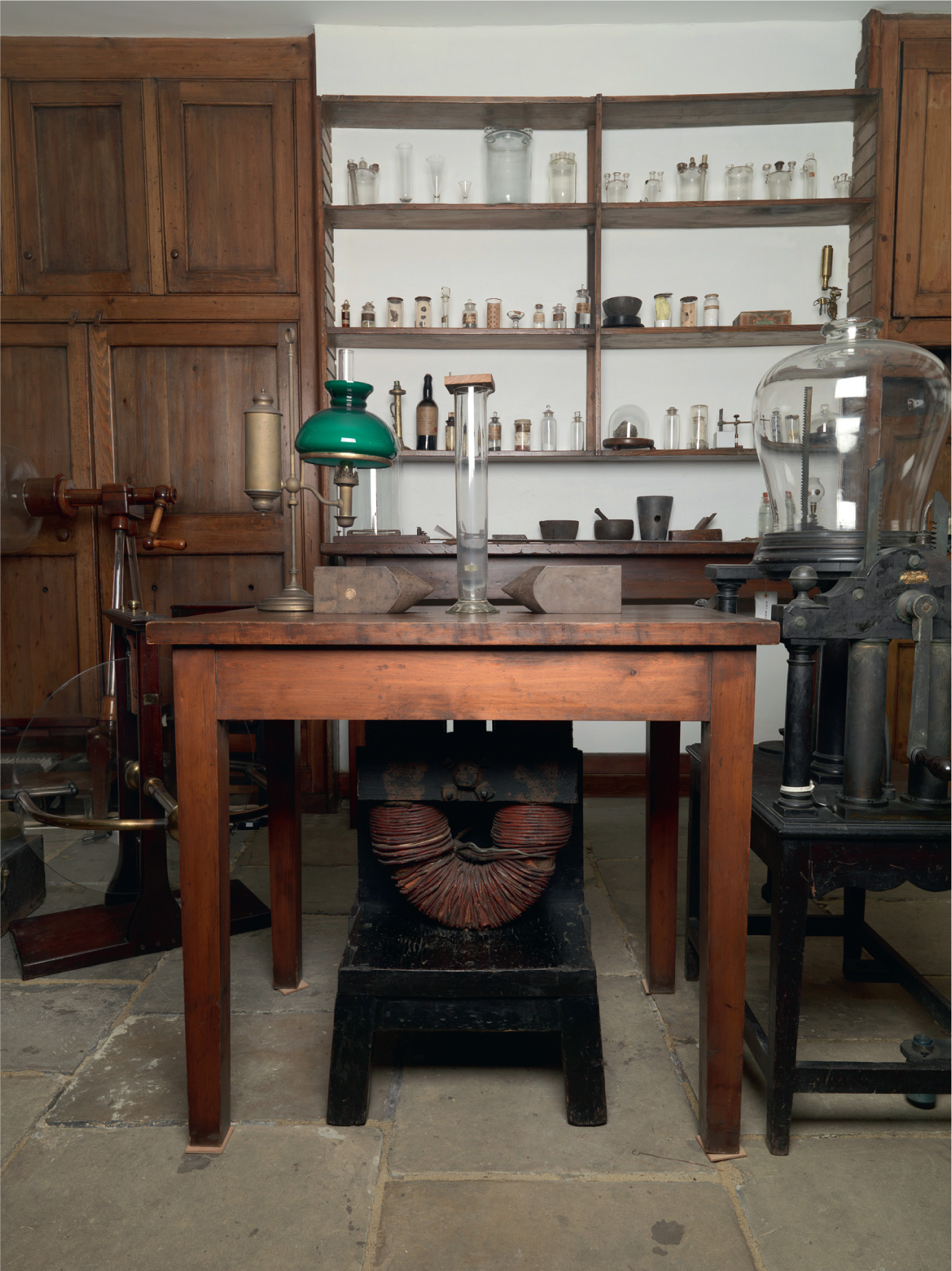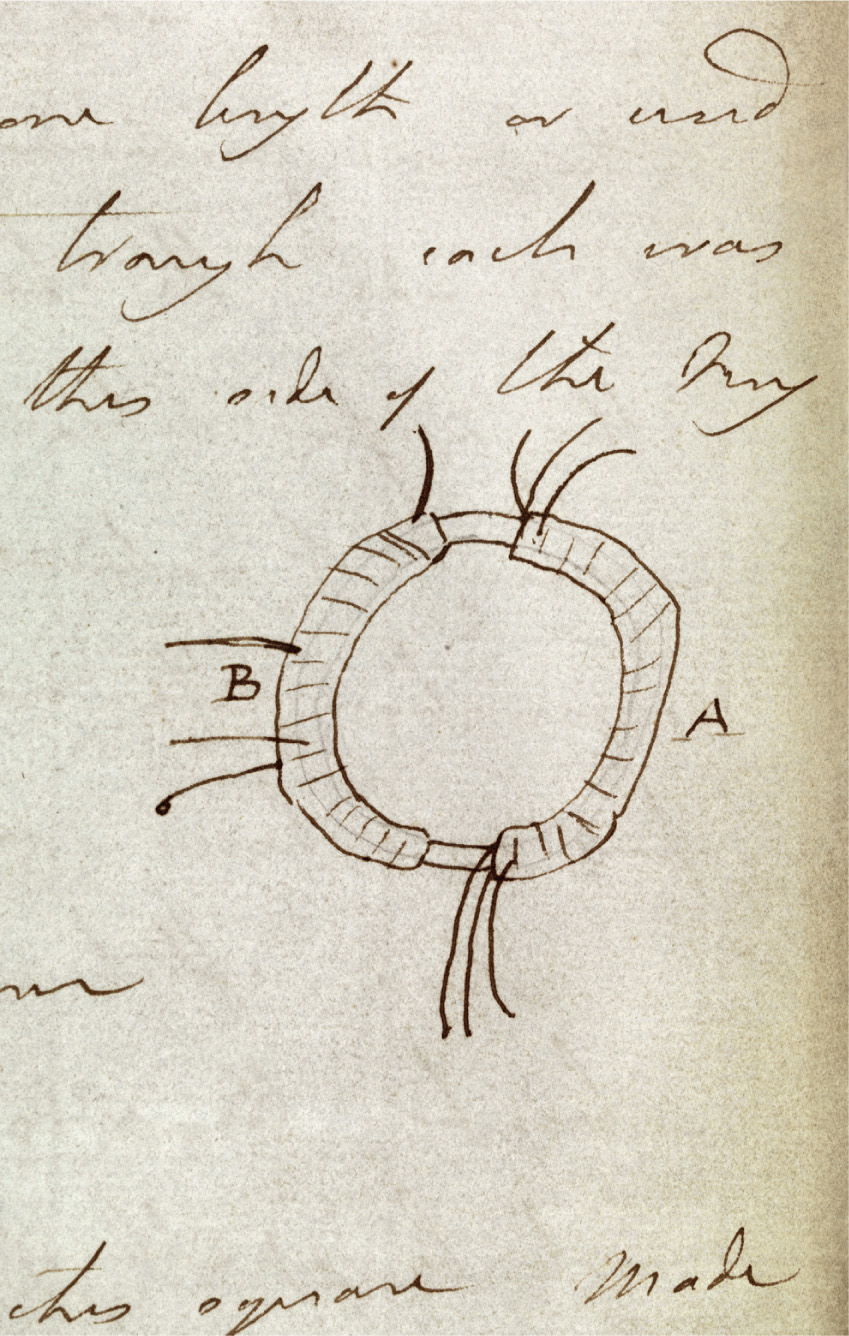
Reconstruction of part of the laboratory belonging to British physicist Michael Faraday (1791–1867), now part of the museum at the Royal Institution, London, in the basement where he worked.
Two key inventions drove the technological revolution. One was the steam engine (see here). The other, arguably even more important, was the electric generator/motor combination. Several people contributed to this development, but the key experiments were carried out by Michael Faraday, working at the Royal Institution in London.
Faraday’s interest in electricity was stimulated by news of Ørsted’s discovery of the magnetic effect associated with an electric current. He realized that a wire carrying an electric current should be forced to move in a circle round a fixed magnet, and in 1821 devised an experiment to demonstrate this effect. A magnet was stuck vertically up through a pool of mercury in a glass container, and a wire was dangled from a support above the dish with its end in the mercury. Mercury is both a liquid and a conductor of electricity, so the wire could move about in the mercury when a current flowed without breaking the electrical circuit. When the wire was attached to a battery via the mercury, the end of the wire in the dish did indeed move in a circle round the magnet, exactly as Faraday had expected. In a variation on the theme, the wire was fixed vertically, but the magnet was free to rotate, and circled round the wire when the current was switched on. This was the genesis of the idea of the electric motor, converting electricity into mechanical motion. But Faraday was diverted into other work, chiefly in chemistry, and in 1825 became Director of the Laboratory at the Royal Institution, where he introduced a series of popular lectures about science. All of this gave him little time for electrical work, and he only returned to the puzzle at the beginning of the 1830s. The question he wanted to answer was: if an electric current can induce a magnetic force in its vicinity, can a magnet induce an electric current in a nearby wire?
By then, several people had found that if a magnetic compass needle is suspended by a thread above a horizontal spinning metal disc the needle is deflected, but the phenomenon was not understood. Faraday’s work gave the answer, but what he found was not what he started looking for.

In 1831, Faraday was using an adapted form of a solenoid (see here) in his experiments. He had a metal ring made of iron about 2 centimetres thick bent in a circle about 15 centimetres in diameter. On opposite sides of the ring, coils of wire were wound as in a conventional solenoid. One coil was connected to a battery, the other to a sensitive galvanometer. What Faraday was looking for was any deflection of the galvanometer, indicating a flow of current in the second coil, when an electric current was flowing through the first coil. He anticipated that the current in the first coil would induce magnetism in the iron ring, and that the magnetism would induce a current in the second coil.

What he actually found was that when a steady electric current was flowing in the first coil, nothing at all happened to the galvanometer. But on 29 August 1831, to his surprise, Faraday noticed that the galvanometer needle flickered just at the moment the current to the first coil was turned on, then fell back to zero. It flickered again when the current was turned off. Through this and further experiments Faraday established that a steady electric current, producing a steady magnetic field in the ring, did not produce any induced current. But as long as the first current was changing, which means as long as the magnetic field in the ring was changing, a current was induced. He soon found that simply moving an ordinary bar magnet in and out of a solenoid produced a current in the coil as long as the magnet was moving. Just as moving electricity induces magnetism, so moving magnetism induces electricity.
In the spinning disc experiment, what is happening is that because the disc is moving relative to the magnet of the compass needle, electric currents flow in the disc; these currents induce a magnetic field that affects the needle. Faraday’s work opened the way to generate electricity more or less on demand by machines that move magnets in circles around suitably coiled wires, or by moving those wires past magnets, since what matters is the relative motion. Just as electricity could be converted into mechanical motion, mechanical motion could be converted into electricity. And electricity could be generated in one place, carried by wires to another place, and used to drive motors there. In May 1881 – just half a century after Faraday noticed the flickering galvanometer needle in his lab – the first electric tram in the world was being tested at Lichterfelde near Berlin.